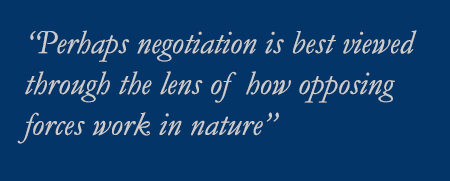Negotiation has become commonplace, but like driving a car it’s easy to mistake competency for proficiency. Perhaps negotiation is best viewed through the lens of how opposing forces work in nature. An “inelastic” collision occurs when two bodies collide, and there’s no bounce. An “elastic” collision is just the opposite––two bodies collide, and there’s bounce. Should negotiation be viewed as a collision that’s elastic or inelastic?
Elastic negotiation. Elastic negotiation is akin to a process where the forces created by one side can be seen to affect the other. There’s bounce; there appears to be a reaction. In these instances, it would seem there’s great opportunity that an agreement can be reached.
Inelastic negotiation. Inelastic negotiation is akin to a process where the forces created by one side cannot be seen to affect the other. There’s no bounce; there appears to be no reaction. In these instances, it would seem there’s little opportunity that an agreement can be reached.
Your typical negotiator employs the same strategy in both instances, but this is usually a mistake. Your strategy in an elastic negotiation is not to disrupt the natural flow of things––the case is trending toward settlement and your words and actions should be designed to assist what’s occurring naturally. Your strategy in an inelastic negotiation is to disrupt the natural flow of things––the case is not trending toward settlement and your words and actions should be designed to create new pathways and introduce new elements which will enable entrenched positions to be  reevaluated.
reevaluated.
Both require a deft touch, but the dynamics at play for each differ dramatically. Methods that work for one will not necessarily work for the other. For Plaintiff’s attorneys, there are some other things to keep in mind as well:
“When the final result is expected to be a compromise, it is often prudent to start from an extreme position,”––John Maynard Keynes.
Mindset. Your assumption should be the case will not settle. So, there’s no point in providing your opponent with a blueprint of your ultimate strategy. While the basic facts must be described and your theory of liability set forth, you do not need to let your opponent know every area you intend to cross-examine upon at trial. Assume the case will not settle––your case should be as strong after the negotiation as it was before.
Somehow Make Clear You Would Prefer Not to Settle. Fisher and Ury made famous the phrase BATNA—best alternative to a negotiated agreement––and you should ideally seek to convince your opponent (as well as the Neutral) that not settling the case will actually be a more favorable outcome for you and your client. If nothing else, not settling will enable the Plaintiff to seek and obtain an even greater amount than what’s being discussed today. “People think of negotiating power as being determined by resources like wealth, political connections, physical strength, friends, and military might. In fact, the relative negotiating power of two parties depends primarily upon how attractive to each is the option of not reaching agreement.”[1]
Ignore the Clock. Don’t fall for the old stratagem of “the price is only good until 5:00 P.M. today.” Negotiating as if time has run out is a sure way to be shortchanged. (In certain instances, one response to this can be “In that case, our counter of … is only good until 5:00 P.M. as well…”) Writes Herb Cohen: “Why did the debacle occur? Because my hosts knew my deadline and I didn’t know theirs. They held off making concessions, correctly anticipating that I wouldn’t allow myself to go home empty handed. Furthermore, the impatience that I undoubtedly displayed conveyed my belief that this departure deadline was somehow sacred. As if this would be the last plane to leave Tokyo for all time.”[2]
Be Patient. It’s not unusual for a second, or even third, negotiation to be required. The parties need the space to acquire a sense of perspective and time to think. Sometimes the very last negotiations occur during the trial itself. By the way, there are grey areas––just as in nature are there partially inelastic collisions so too are there partially inelastic negotiations. These gradations of grey––think of the infinitely subtle textures of dawn and dusk––can reveal quite a lot: your task is simply to pay close enough attention so as not to miss what’s there to be seen.
[1] Robert Fisher, William Ury, Getting to Yes: Negotiating Agreement Without Giving In, Pg. 106 (Penguin Books 1983.
[2] Herb Cohen, You Can Negotiate Anything, pg. 95 (Bantam Books 1982)




